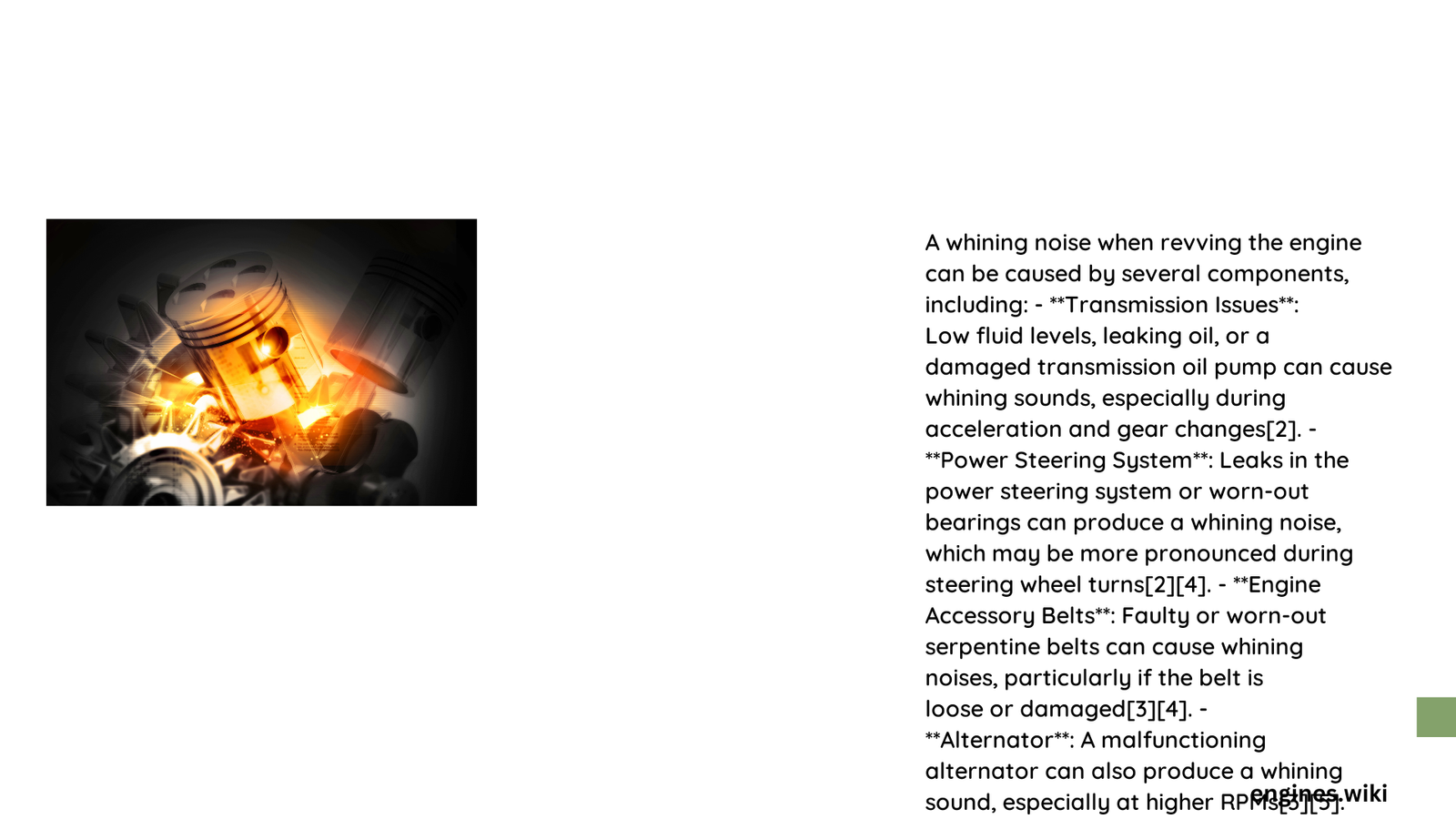Whining Noise When Revving Engine: A Comprehensive Diagnostic Overview
A whining noise when revving the engine can signal critical mechanical problems that demand immediate attention. This mysterious sound often indicates underlying issues with crucial vehicle components like alternators, power steering systems, or transmission mechanisms. Ignoring these warning signs could lead to expensive repairs and potential vehicle breakdown, making prompt diagnosis and resolution essential for maintaining your vehicle’s performance and longevity.
What Causes Whining Noise During Engine Acceleration?
Alternator Problems: Primary Suspect
| Component | Potential Issue | Symptoms | Estimated Repair Cost |
|---|---|---|---|
| Alternator Bearings | Wear and Deterioration | High-pitched whine during acceleration | $200 – $600 |
| Alternator Pulley | Misalignment | Intermittent squealing | $100 – $300 |
| Voltage Regulator | Electrical Malfunction | Inconsistent whining | $50 – $250 |
Key Diagnostic Indicators:
– Noise increases with engine RPM
– Whining becomes more pronounced under electrical load
– Potential battery charging inconsistencies
Power Steering System Complications
When power steering components experience wear or fluid issues, they can produce distinctive whining sounds during engine revving. Critical factors include:
- Fluid Level Inspection
- Check power steering fluid reservoir
- Look for visible leaks around hoses and connections
-
Verify fluid color and consistency
-
Pump Wear Assessment
- Listen for whining during steering wheel turns
- Monitor noise intensity during acceleration
- Check for hydraulic system pressure drops
Transmission-Related Whining Scenarios
Potential Transmission Noise Sources:
– Low transmission fluid
– Worn gear teeth
– Damaged transmission pump
– Internal bearing deterioration
Diagnostic Approach:
– Perform comprehensive fluid level check
– Analyze noise pitch and frequency
– Conduct professional diagnostic scan
How to Troubleshoot Whining Noise?
Step-by-Step Diagnostic Process
- Initial Sound Verification
- Record engine noise
- Note RPM range when sound occurs
-
Identify precise location of whining
-
Component Isolation Technique
- Remove serpentine belt
- Start engine
-
Determine if noise persists
-
Professional Diagnostic Recommendations
- Use specialized automotive stethoscope
- Employ digital sound analysis tools
- Consult certified mechanic
When Should You Seek Professional Help?
Warning Signs Requiring Immediate Attention:
– Persistent whining beyond 3,000 RPM
– Accompanying performance degradation
– Visible fluid leaks
– Unusual vibration patterns
Cost Considerations
| Repair Complexity | Estimated Cost Range | Recommended Action |
|---|---|---|
| Minor Component Replacement | $100 – $500 | DIY Possible |
| Major System Repair | $500 – $3,000 | Professional Required |
| Complete System Replacement | $2,000 – $5,000 | Expert Consultation |
Prevention Strategies
- Regular maintenance schedule
- Timely fluid replacements
- Annual comprehensive vehicle inspection
- Address minor noises immediately
Technical Insights
Whining noises typically emerge from mechanical friction, electrical system irregularities, or fluid dynamics within vehicle components. Understanding these nuanced interactions helps diagnose and resolve complex automotive sound issues effectively.
Pro Tip: Modern vehicles often have sophisticated onboard diagnostic systems that can provide early warning signals before significant mechanical failures occur.
Final Recommendations
- Document noise characteristics
- Perform systematic diagnostic checks
- Consult professional mechanics
- Prioritize preventative maintenance
References:
– [SAE Technical Paper on Vehicle Noise Diagnostics]
– [Automotive Maintenance Journal]
– [Professional Mechanic’s Diagnostic Guide]

